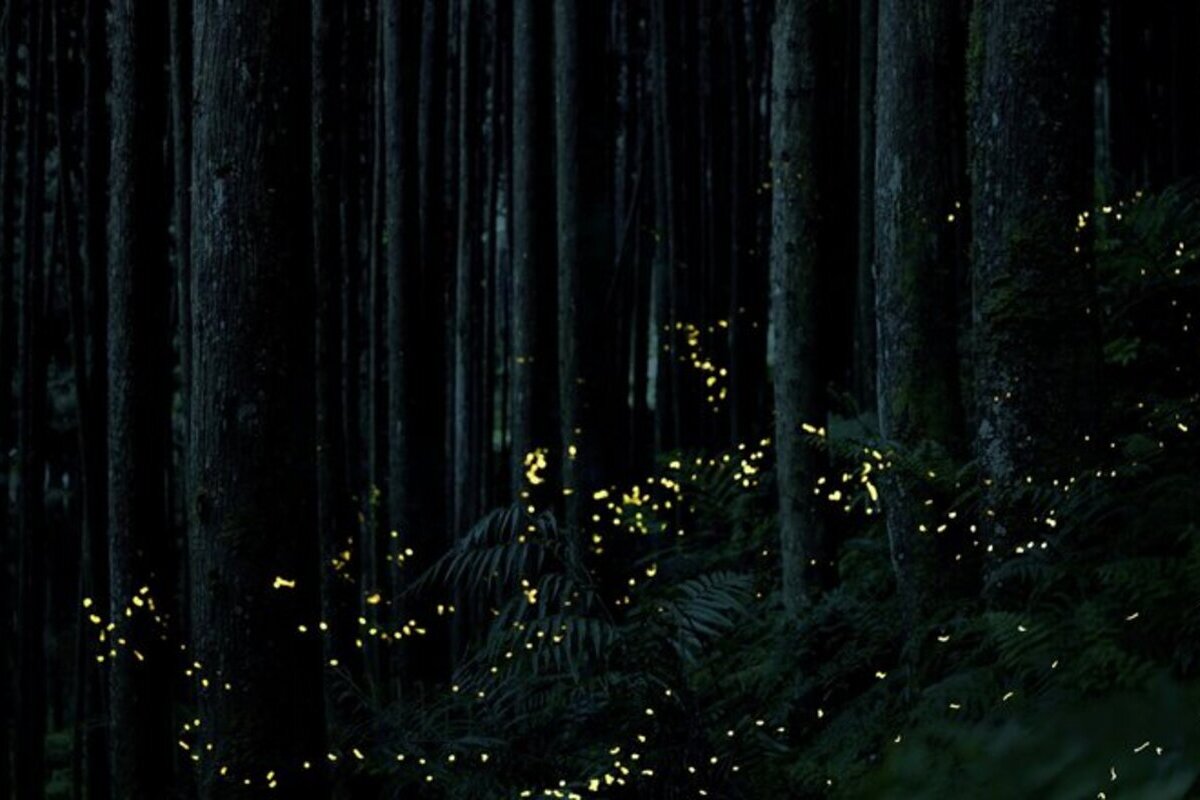Fireflies have fascinated us since childhood with their magical glow that seems almost fairytale-like. Behind this captivating display, however, lie complex biochemical processes, evolutionary adaptations and extraordinary traits that make these insects truly unique. They inhabit various continents and play an important role in ecosystems, while possessing many surprising features. In this article, we’ve gathered interesting facts about fireflies that you may not know. Some will amaze you with scientific explanations, while others will surprise you with the unusual behavior of these luminous beetles.
- Fireflies glow thanks to a chemical reaction known as bioluminescence. In specialized cells on their abdomen, luciferin, oxygen and the enzyme luciferase interact. The result is light without heat, which makes it extremely energy-efficient. This type of illumination is considered one of the most efficient in nature.
- The light produced by fireflies can vary in color, ranging from green to yellow and even bluish hues. Depending on the species, the light’s color may serve different purposes. Some species emit a steady light, while others flash at specific intervals. This helps them find mates or scare away predators.
- Most fireflies are found in tropical and subtropical regions, particularly in Southeast Asia and South America. There, they sometimes form large groups and flash synchronously, creating spectacular light shows. Tourists from around the world travel to witness these natural displays. One of the most famous viewing spots is the jungles of Malaysia.
- Fireflies are not a single, uniform type of insect seen in meadows during summer. In fact, there are over 2,000 known species of fireflies that vary in size, body shape, color and lifestyle. Some are active during the day and don’t glow at all. Others spend most of their lives as larvae underground or in damp moss.
- Females of certain firefly species lack wings and cannot fly. They glow while lying on the ground or on plants to attract flying males. This is an adaptation to their environment and reproductive behavior. Such traits are especially common in northern species.
- Fireflies use their glow not only to attract mates but also for defense. Their light serves as a warning signal to predators that they are unpalatable or even toxic. Birds and frogs quickly learn to avoid them. This is a natural warning mechanism similar to bright colors in poisonous frogs.
- Firefly larvae also glow, which is one of their most remarkable features. They usually do so at night near moist soil or water. This glow can serve both as protection and a hunting tool. Some larvae attract small insects with faint lights.
- In some cultures, fireflies are seen as symbols of the soul, magic or hope. In Japanese tradition, they are associated with love and spiritual purity. In Chinese poetry, they often symbolize nighttime beauty and romance. This shows that people have long been enchanted by their mysterious light.
- Fireflies regulate their glow not just chemically but also through their nervous system. They can consciously turn their light on and off when needed. This allows them to communicate with great precision. It’s another example of how specialized these insects are.
- Females of some firefly species mimic the flash patterns of other species to lure males and then eat them. This is an example of aggressive mimicry in nature. Males who respond to the wrong signal become prey. This behavior is found in beetles of the genus Photuris.
- Fireflies are highly sensitive to environmental pollution and artificial light. Their populations are decreasing due to urbanization, climate change and pesticide use. Artificial lighting disrupts their ability to communicate and find mates. In many regions, they are already disappearing.
- Despite their name, fireflies are not flies but beetles. They belong to the family Lampyridae in the order Coleoptera. Their bodies are usually soft, with distinct antennae and elongated abdomens. These features help scientists accurately identify and classify them.
- In some countries, fireflies are collected and used in laboratory research. Their enzyme luciferase has become an important tool in biomedical studies. Scientists use it to study cancer cells, gene activity and other complex processes. Even a tiny insect can lead to major scientific breakthroughs.
- Firefly larvae feed on other small invertebrates, especially snails and worms. They inject a paralyzing fluid into their prey that breaks down tissue. Then they suck out the liquified contents, making their feeding method highly effective. Such behavior is unusual for insects of their size.
- Adult fireflies usually live for a very short time. Their lifespan typically lasts only a few days or weeks, and their primary focus is reproduction. Most of their life is spent in the larval stage, which can last up to two years. This life cycle is typical of many firefly species.
- Some firefly species do not glow at all, despite their name. These species lost the ability to produce light through evolution. Instead, they attract mates using scent or touch. They are often active during the day.
- In the US state of Pennsylvania, there is an annual firefly festival. People gather to watch thousands of fireflies blink in their natural habitat. The event attracts tourists and promotes ecological education. Nature continues to inspire people to protect it.
These interesting facts about fireflies offer a fresh perspective on these familiar insects. Their ability to glow, communicate, defend and adapt is truly fascinating. In a world where humans have an increasing impact on nature, it’s important to notice even the smallest of creatures. These incredible facts about fireflies prove that even tiny insects can hold great wonders of the natural world.





